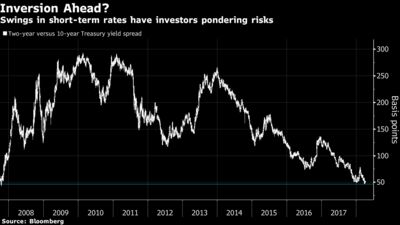When it comes to the Treasury yield curve, going inverted isn’t the “great move” that Tom Cruise boasted about pulling off when piloting his F-14 Tomcat jet in the cult classic movie Top Gun.
After widening in early February, the trend has reversed with yields on two-year notes approaching those on 10-year securities again. That’s put the risk of an inverted curve, when short-term yields are higher, back on analysts’ radar. JPMorgan Chase & Co. strategists say a slight inversion seen already in money-market forward rates that serve as a proxy for the federal funds rate means it might only be “a matter of time until” until the overall curve turns on its head.
The shape of the curve is not just a bond wonk matter either, given it has implications for the longevity of America’s economic recovery, bank earnings, consumer behavior and share prices. An inverted curve has preceded the majority of all U.S. recessions over recent decades.

“The curve flattening is a big deal,” said Joseph LaVorgna, chief Americas economist for Natixis North America LLC. “The market is telling you something and part of it is that overall risk-aversion is back. This comes because the Fed is taking liquidity out of the marketplace.”
If the Fed does plow ahead as they have signaled — lifting the funds rate to about 3.38 percent by 2020, that will likely spark an economic downturn, Lavorgna says. And over the past three decades, recessions on average followed curve inversions by five quarters, he adds.
The Fed increased its target rate last month by a quarter percentage point to range of 1.5 percent to 1.75 percent. Officials’ quarterly projections signal three interest-rate increases overall this year.
OIS RATE
The one-month U.S. overnight indexed swap (OIS) rate traded in the forward market two years into the future is above that seen three years from now. That OIS inversion has only happened three times in 20 years: in 2005, 2000 and 1998, JPMorgan Chase strategist Nikolaos Panigirtzoglou wrote in a note.
The short-end inversion, besides foreshadowing the same for two- and 10-year note yields, either means traders are pricing in a Fed policy mistake or the end of the economic cycle, said Panigirtzoglou.
James Athey, a senior money manager at Aberdeen Standard Investments Ltd. in London, says financial firms that typically seek profits by borrowing at short-term rates that are lower than longer-term — where they lend — are at risk in an inversion.
“When that interest margin is low and doesn’t cover their costs it forces them to potentially change their business model,” said Athey at Aberdeen, which manages 576 billion pounds ($813 billion). “At this stage of the cycle you’d want banks to be acting pro-cyclically and doing safe, very secure, lending. If there’s a very little gap between the two and 10-year yields, that maybe changes those dynamics” and “can potentially hamper the normalization of the economy.”